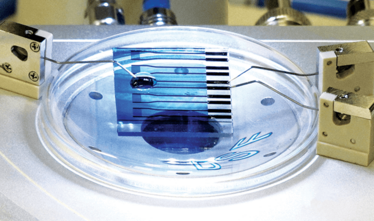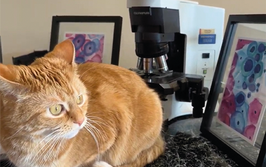Simple Sample Sensing
Carlos Cesar Bof Bufon explains the first phthalocyanine-based water-gated transistor for disease diagnosis
With a spotlight on everything from breath tests to dogs’ noses, biosensors are an increasingly important aspect of diagnostic research. But not every sensor offers the same benefits – and it’s important to find a balance between cost, ease-of-use, sensitivity and specificity. To meet this diverse set of needs, we propose refinements to an existing technology, the “water-gated organic transistor,” to improve its ability to assist in the diagnosis of numerous diseases including cancer, Alzheimer’s and Parkinson’s (1).

The National Nanotechnology Laboratory’s nanoscale biosensor for cancer and neurodegenerative disease.
The device is an organic transistor that works on liquid samples. The sample forms a fundamental part of the device, resting atop a pair of electrodes coated with an organic semiconductor film. A metallic wire in the liquid (the “gate electrode”) allows users to control the capacitive coupling between the charges in the semiconductor film and in the sample simply by applying suitable voltages at the electrodes.
What makes our transistor attractive for biosensing is the biomolecule-friendly aqueous environment, the low (≤1 V) operational voltages, and the ability to achieve high specificity by adding biorecognition elements at the gate electrode. The result is an electrical signal correlated to analyte concentration. It’s not new technology – similar transistors are already used to detect molecules like dopamine, cytokines, and penicillin. The novelty in our work is that it’s the first time such a device has been used to detect glutathione S-transferase (GST), an enzyme related to a wide range of diseases. Despite its sensitivity, the test itself is straightforward: we simply attach a single layer of reduced glutathione (GSH) peptide to the gate surface and exploit the well-known specific interaction between GSH and GST, without needing any other chemicals or labeling molecules.
We believe that water-gated organic transistors can be used as biosensors for molecules related to a variety of pathologies. But to do so, we’ll need thoughtful device design and engineering – not always an easy task. In our opinion, the possibilities – and the challenges – are numerous! To overcome the obstacles, we need interdisciplinary collaboration between physicists, chemists, physicians and health specialists to identify relevant analytes, determine safe concentrations, select sample types, and tackle technological trouble. In our laboratory, we work on device development, so we don’t have much close contact with health professionals. We know, though, that there’s currently no single test for diseases like cancer, Alzheimer’s or Parkinson’s; instead, diagnosis is based on a combination of signs and symptoms, medical history, and imaging (which can be expensive and inconvenient). Our vision is that point-of-care biosensors will become an additional tool for the diagnosis of such pathologies, decentralizing examinations and reducing costs.
But before water-gated organic transistors can help pathologists with day-to-day diagnosis, we have some work to do: evaluating device stability (both in operation and storage), studying other organic semiconductors and determining the most appropriate materials, investigating the role played by interferents, and, most importantly, monitoring analytes in real samples. But that work is underway, and although the challenges ahead may sound intimidating, we believe that these devices represent a viable – if timid – step in the direction of clinical change.
- RF de Oliveira et al., “Water-gated phthalocyanine transistors: operation and transduction of the peptide–enzyme interaction”, Org Electron, 31, 217–226 (2016).
Carlos Cesar Bof Bufon is Head of the Laboratory of Functional Devices and Systems at the Brazilian Nanotechnology National Laboratory (LNNano), Campinas, Brazil




















